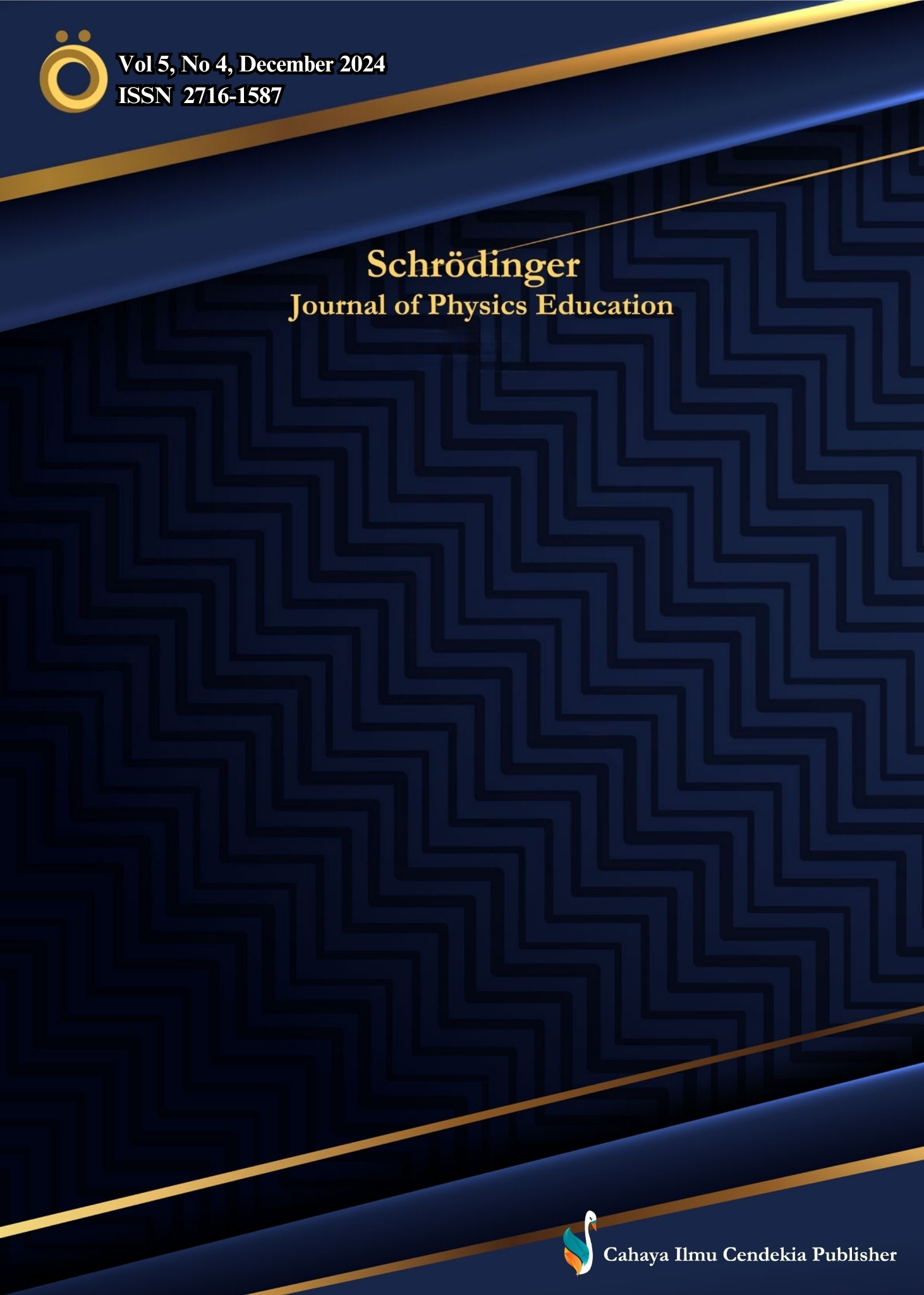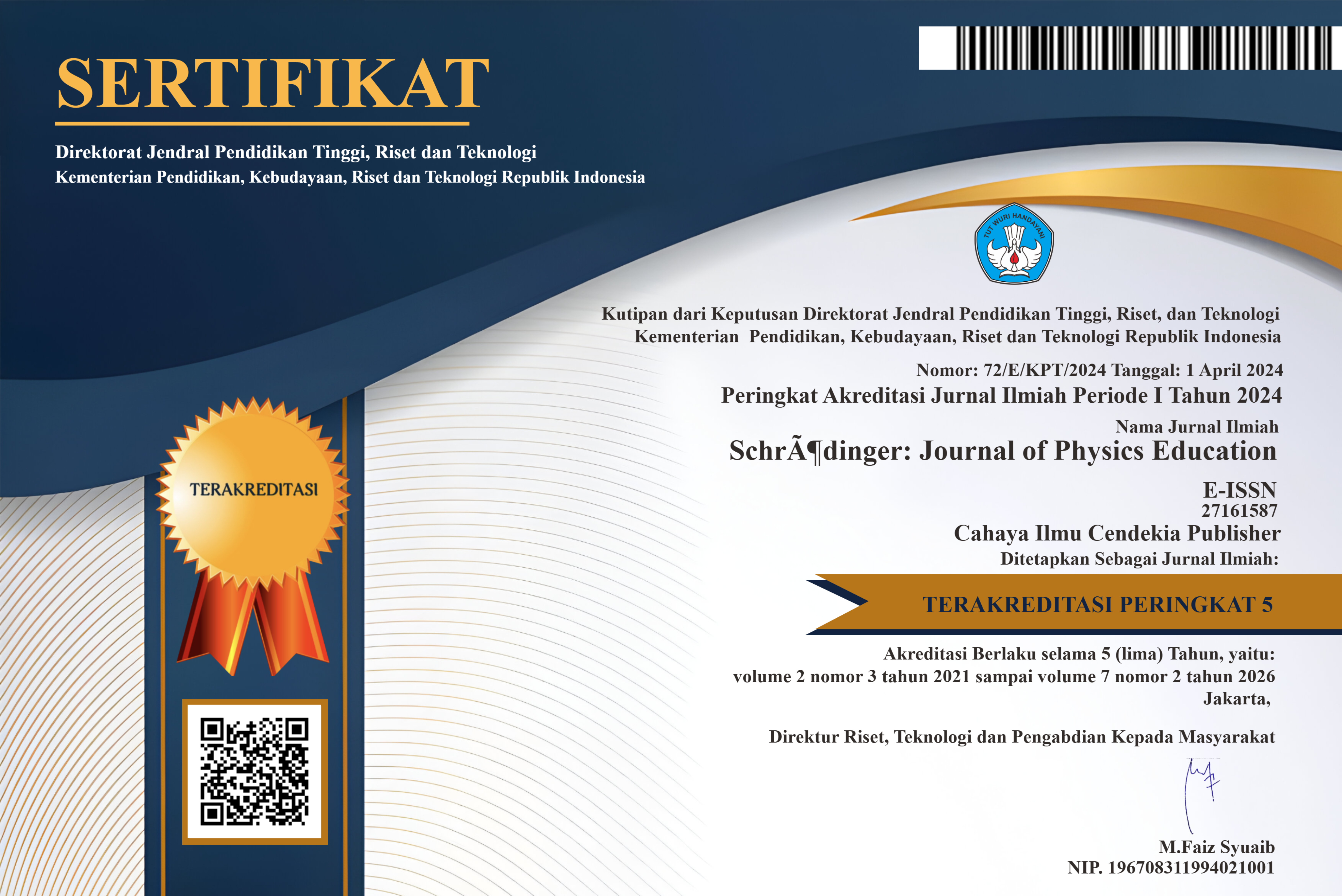Effectiveness of Cooperative Problem Solving (CPS) Learning with the Science Process Skills Approach on the subject of Simple Harmonic Motion
Abstract
Curpose of the study: The purpose of the research that has been carried out is to analyze the effectiveness of cooperative problem solving learning with the science process skills approach in improving students' understanding of the subject of simple harmonic motion.
Methodology: The method used is a quasi-experiment with a pretest-posttest control group design. The subject of the study was students of class X science from two high schools who were selected purposively. The data was analyzed with a Statistical Descriptive Test to describe the learning outcome data from two sample classes.
Main Findings: The results of the analysis showed that the average posttest score of the experimental class was higher than that of the control class. The average score of the experimental class showed a high improvement category, while the control class only achieved a moderate category. CPS learning with the SPS approach has proven to be effective because it combines group cooperation and scientific exploration. Students can associate theory with practice, so that the understanding of concepts becomes more deep.
Novelty/Originality of this study: This study introduces a novel integration of Cooperative Problem Solving (CPS) with Science Process Skills (SPS) in teaching Simple Harmonic Motion. Unlike traditional methods, this approach fosters both collaborative problem-solving and scientific thinking, enhancing students' conceptual understanding and practical application. It advances existing knowledge by demonstrating how CPS-SPS synergy can bridge theoretical physics and real-world problem-solving skills effectively.
References
E. Y. Wijaya, D. A. Sudjimat, and A. Nyoto, “Transformasi pendidikan abad 21 sebagai tuntutan pengembangan sumber daya manusia di era global,” in Prosiding Seminar Nasional Pendidikan Matematika, 2016, pp. 263–278.
H. Helen and A. Kusdiwelirawan, “Pengaruh model pembelajaran creative problem solving (CPS) terhadap hasil belajar fisika dan kemampuan berpikir kreatif peserta didik,” WaPFi (Wahana Pendidik. Fis., vol. 7, no. 1, pp. 51–60, 2022.
F. Alfawaire and T. Atan, “The effect of strategic human resource and knowledge management on sustainable competitive advantages at Jordanian universities: The mediating role of organizational innovation,” Sustain., vol. 13, no. 15, 2021, doi: 10.3390/su13158445.
D. Ariyansah, L. Hakim, and R. Sulistyowati, “Pengembangan e-LKPD praktikum fisika pada materi gerak harmonik sederhana berbantuan aplikasi phyphox untuk meningkatkan pemahaman konsep peserta didik,” J. Penelit. Pembelajaran Fis., vol. 12, no. 2, pp. 173–181, 2021.
F. Wardani, “An analysis of student’s concepts understanding about simple harmonic motion: Study in vocational high school,” J. Phys. Conf. Ser., vol. 1511, no. 1, 2020, doi: 10.1088/1742-6596/1511/1/012079.
O. I. González-Peña, G. Morán-Soto, R. Rodríguez-Masegosa, and B. M. Rodríguez-Lara, “Effects of a thermal inversion experiment on stem students learning and application of damped harmonic motion,” Sustain., vol. 13, no. 2, pp. 1–15, 2021, doi: 10.3390/su13020919.
N. K. Sukmawati and T. Y. E. Siswono, “Analisis kemampuan komunikasi matematis siswa melalui pemecahan masalah kolaboratif,” MATHEdunesa, vol. 10, no. 3, pp. 480–489, 2021.
G. Pilania, “Machine learning in materials science: From explainable predictions to autonomous design,” Comput. Mater. Sci., vol. 193, 2021, doi: 10.1016/j.commatsci.2021.110360.
D. Darmaji, A. Astalini, D. A. Kurniawan, and E. Triani, “The effect of science process skills of students argumentation skills,” J. Inov. Pendidik. IPA, vol. 8, no. 1, pp. 78–88, 2022, doi: 10.21831/jipi.v8i1.49224.
D. P. Nengsih, I. Koto, A. Defianti, Nirwana, and H. Johan, “The effect of static fluid pressure learning with predict- observe-explain (POE)-oriented student worksheets on science process skills,” J. Pendidik. Fis., vol. 11, no. 3, pp. 297–312, 2023, doi: 10.26618/jpf.v11i3.11842.
E. Trisianawati, “Penerapan Model Inkuiri Terbimbing Pada Materi Gerak Harmonik Sederhana Di Kelas XI IPA MAN Sanggau Ledo,” JIPF (Jurnal Ilmu Pendidik. Fis., vol. 1, no. 1, pp. 23–28, 2016.
A. Djou, T. J. Buhungo, Supartin, and A. Arbie, “Practicality of learning devices in problem-based learning implementation in contextual teaching and learning approach,” J. Pijar Mipa, vol. 17, no. 6, pp. 748–753, 2022, doi: 10.29303/jpm.v17i6.4245.
A. Astalini, D. Darmaji, D. A. Kurniawan, F. P. Sinaga, M. Z. Azzahra, and E. Triani, “Identification the 2013 curriculum teacher’s book to determine the character values of class X students on circular motion material,” J. Pendidik. Sains Indones., vol. 11, no. 3, pp. 545–558, 2023, doi: 10.24815/jpsi.v11i3.28567.
S. E. Septi, D. Deswalman, M. Maison, and D. A. Kurniawan, “Pengaruh Model Pembelajaran Discovery Learning Terhadap Keterampilan Proses Sains Siswa Pada Mata Pelajaran Fisika di SMAN 10 Kota Jambi,” Phi J. Pendidik. Fis. dan Terap., vol. 7, no. 2, pp. 10–18, 2022.
E. Prihatini, “Pengaruh metode pembelajaran dan minat belajar terhadap hasil belajar IPA,” Form. J. Ilm. Pendidik. MIPA, vol. 7, no. 2, 2017.
I. K. Mahardika, M. Maryani, and S. C. C. Murti, “Penggunaan Model Pembelajaran Creative Problem Solving Disertai LKS Kartun Fisika pada Pembelajaran Fisika di SMP,” J. Pembelajaran Fis., vol. 1, no. 2, pp. 231–237, 2021.
E. B. Ginting, S. E. Purwanto, and A. Faradillah, “Pengaruh model pembelajaran creative problem solving (cps) terhadap kemampuan berpikir kreatif matematis siswa,” Gammath J. Ilm. Progr. Stud. Pendidik. Mat., vol. 4, no. 1, pp. 9–16, 2019.
R. G. S. Senja and D. Supriyatna, “Konsep Dasar Mekanika Fluida Dan Karakteristiknya,” Kohesi J. Multidisiplin Saintek, vol. 3, no. 3, pp. 6–20, 2024.
C. Mylonas, E. Mitsakis, and K. Kepaptsoglou, “Criticality analysis in road networks with graph-theoretic measures, traffic assignment, and simulation,” Phys. A Stat. Mech. its Appl., vol. 629, p. 129197, 2023, doi: https://doi.org/10.1016/j.physa.2023.129197.
H. Siswono, “Analisis Pengaruh Keterampilan Proses Sains Terhadap Penguasaan Konsep Fisika Siswa,” Momentum Phys. Educ. J., vol. 1, no. 2, p. 83, 2017, doi: 10.21067/mpej.v1i2.1967.
R. Wahyuni, M. Mariyam, and D. Sartika, “Efektivitas model pembelajaran Creative Problem Solving (CPS) dalam meningkatkan kemampuan berfikir kritis matematis siswa pada materi persamaan garis lurus,” JPMI (Jurnal Pendidik. Mat. Indones., vol. 3, no. 1, pp. 26–31, 2018.
A. Latif and I. Safitri, “Pengaruh Metode Pembelajaran Problem Solving Terhadap Aktivitas Belajar Siswa,” J. Eduscience, vol. 7, no. 2, pp. 1–9, 2020.
Y. Subekti and A. Ariswan, “Pembelajaran fisika dengan metode eksperimen untuk meningkatkan hasil belajar kognitif dan keterampilan proses sains,” J. Inov. Pendidik. IPA, vol. 2, no. 2, pp. 252–261, 2016.
Y. Alam, “Pengaruh Keterampilan Proses Sains dalam Pembelajaran Fisika pada Matakuliah Termodinamika,” Briliant J. Ris. dan Konseptual, vol. 4, no. 3, pp. 282–288, 2019.
Z. Shana and E. S. Abulibdeh, “Science practical work and its impact on students’ science achievement,” J. Technol. Sci. Educ., vol. 10, no. 2, pp. 199–215, 2020, doi: 10.3926/JOTSE.888.
F. P. Sinaga, Jurhana, Yusrita, and M. Hidayat, “Analisis penggunaan metode mengajar (metode demonstrasi, metode eksperimen, metode inquiry, dan metode discovery di SMA Negeri 11 Kota Jambi),” Relativ. J. Ris. Inov. Pembelajaran Fis., vol. 5, no. 2, pp. 103–110, 2022, doi: https://doi.org/10.29103/relativitas.v5i2.7830.
A. Tupalessy, C. T. Kereh, and S. Singerin, “Penggunaan laboratorium virtual PhET dalam model discovery learning pada materi gerak harmonik sederhana,” Sci. Map J., vol. 3, no. 2, pp. 47–55, 2021.
Y. Irhasyuarna et al., “Integrated science teaching materials with local wisdom insights to improve students’ critical thinking ability,” BIO-INOVED J. Biol. Pendidik., vol. 4, no. 3, p. 328, 2022, doi: 10.20527/bino.v4i3.14148.
H. Taherdoost, “Data Collection Methods and Tools for Research; A Step-by-Step Guide to Choose Data Collection Technique for Academic and Business Research Projects,” Int. J. Acad. Res. Manag., vol. 2021, no. 1, pp. 10–38, 2021, [Online]. Available: https://hal.science/hal-03741847
I. Abraham and Y. Supriyati, “Desain kuasi eksperimen dalam pendidikan: Literatur review,” J. Ilm. Mandala Educ., vol. 8, no. 3, 2022.
Imam Ghozali, Aplikasi Analisis Multivariate dengan Program IBM SPSS 25. Semarang: Badan Penerbit Universitas Diponegoro, 2018.
M. G. Sulaeman, N. Jusniani, and E. Monariska, “Penggunaan model pembelajaran creative problem solving (CPS) untuk meningkatkan kemampuan pemecahan masalah matematis siswa,” Mathema J. Pendidik. Mat., vol. 3, no. 1, pp. 66–81, 2021.
Copyright (c) 2024 Rachmat Rizaldi, Uswatun Hasanah.S, Syahwin, Sheila Fitriana, Tri Astuti Mardiana

This work is licensed under a Creative Commons Attribution 4.0 International License.
Authors who publish with this journal agree to the following terms:
- Authors retain copyright and acknowledge that the Schrödinger: Journal of Physics Education is the first publisher licensed under a Creative Commons Attribution 4.0 International License.
- Authors are able to enter into separate, additional contractual arrangements for the non-exclusive distribution of the journal's published version of the work (e.g., post it to an institutional repository or publish it in a book), with an acknowledgment of its initial publication in this journal.
- Authors are permitted and encouraged to post their work online (e.g., in institutional repositories or on their website) prior to and during the submission process, as it can lead to productive exchanges and earlier and greater citation of published work.







.png)
.png)








.png)
.png)
.png)







